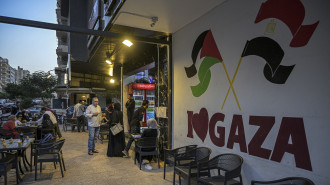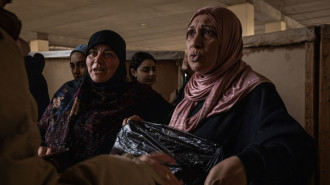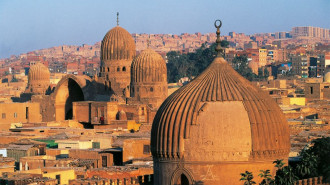
Lebanese artisan Henry Loussian revives lost heritage homes with new open residence

Fifteen years ago, Lebanese jeweller Henry Loussian stepped into an Ottoman era heritage home and was instantly enamoured with the place.
Unable to afford the steep cost of a traditional Beiruti house, he decided to look for an alternative way to bring his dream of owning a piece of his country’s rich architectural history into reality, little realising that his collection would eventually span 100 such pieces.
Loussian has spent over a decade salvaging elements from 100 heritage homes around Beirut that have now been demolished, piecing them together to create his own new residence in the style of the old. This month, Loussian opened its doors to the public as Musée Henry.
Lebanon’s architecture is a unique blend of both Eastern and Western influences, combining Arab, Ottoman and European features while still retaining its own uniquely characterful elements, such as the famous triple arcade windows and red terracotta tiled roofs
“As a small artisan making and selling jewellery in Hamra, there was no way for me to have such a house,” Loussian tells The New Arab. “When I entered this house, I felt like this was me. This is my background, my identity. Beirut is the most beautiful city in the Middle East, and I wanted to do this to revive it again.
“I began collecting in 2008, and started building in 2009,” he explains. “I collected arches, columns, tiles, paintings and furniture. Each house is special, so I wanted what was most special from each. I was dying to have them.”
Situated in the coastal city of Batroun, this beautiful palatial house stands as an embodiment of Loussian’s passion for the traditional Lebanese style, painstakingly assembled over the years. From its high marble columns and balconies to its painted wooden shutters and geometric-tiled floors, everything has been done to ensure an authentic representation.
|
|
“There is no new taste in this house,” Loussian insists. “There is only reviving and imitation. I’m giving these old things a new place because nobody cares about them now.”
Lebanon’s architecture is a unique blend of both Eastern and Western influences, combining Arab, Ottoman and European features while still retaining its own uniquely characterful elements, such as the famous triple arcade windows and red terracotta tiled roofs.
Despite this storied legacy, these beautiful buildings have been steadily disappearing from Lebanon’s capital over time. Restoring and maintaining these structures can be prohibitively expensive, leaving some owners with few options besides either selling them to major developers or simply abandoning them, leaving them to slowly decay.
Demolition applications are handled by the Ministry of Culture on a case-by-case basis, but measures created by the Directorate General of Antiquities to safeguard Lebanon’s heritage houses are often bypassed or ignored in favour of urban modernisation.
In the wake of Lebanon’s dire financial crisis and the widespread destruction caused by the 2020 August 4 Beirut port explosion, the problem has only further intensified. Many older buildings, particularly those in the districts of Gemmayzeh and Mar-Mikhaël, were severely damaged.
“They are classified as historic places, but the Municipality of Beirut is working under the table,” says Loussian. “They don’t have permission to demolish these houses, so they have to work fast because the Municipality gives them permission – even illegally – for only one or two days at most. They have to do it fast.”
|
|
With the contents of these condemned houses being viewed by the disinterested owners as little better than worthless scrap, Loussian seized the opportunity to save what he could by approaching the demolition contractors directly.
“I was buying as-is – regardless of price – because I wanted the authentic windows; the complete tiles,” he explains. “I did not want pieces. Every time they had a new house to demolish, they would call me because I was the best buyer for them.
“It’s so much more interesting to see and feel and smell the houses,” Loussian adds. “I would look for anything that spoke to me; mirrors; chandeliers; chairs; armoires; carpets; beds. It’s the authentic furniture of Lebanese houses. I learned how they remove them from the old houses, and how to rebuild them in my house.”
|
|
Originally, Loussian had intended the finished property to simply be his own private home. However, as stories began to circulate about his years’ long labour of love and the wondrous collection of artefacts he was gathering, he decided to take things a step further by offering guided personal tours of his now so-called Musée Henry.
Loussian hopes that his example will inspire others – especially his fellow Lebanese – to cultivate an interest in their own cultural heritage and, perhaps, a more active role in its conservation.
|
|
“I opened this house for people so that they can enter the splendour of Beirut,” Loussian explains. “It was my turning point, to see one from inside, and I want other people to see them, and maintain them and love them.”
“I’ve always been proud to be Lebanese,” he continues. “The most important thing when you visit other countries is to see things that you don’t have in your own country. We are all different to each other, and we have different origins. Now, the modern style is to be all the same.”
Robert McKelvey is a British freelance journalist and cultural writer based in Lebanon.
Follow him on Twitter: @RCMcKelvey




![Palestinians mourned the victims of an Israeli strike on Deir al-Balah [Getty]](/sites/default/files/styles/image_684x385/public/2024-11/GettyImages-2182362043.jpg?h=199d8c1f&itok=xSHZFbmc)


![The law could be enforced against teachers without prior notice [Getty]](/sites/default/files/styles/image_684x385/public/2178740715.jpeg?h=a5f2f23a&itok=hnqrCS4x)
 Follow the Middle East's top stories in English at The New Arab on Google News
Follow the Middle East's top stories in English at The New Arab on Google News


